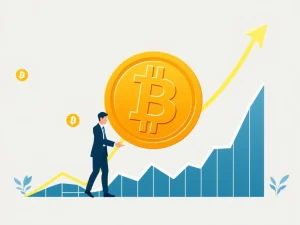Bitcoin’s Bullish Surge: Arthur Hayes Champions Tariffs as Printed Money Fuels Positive Gains

Buckle up, crypto enthusiasts! In a surprising twist, BitMEX co-founder Arthur Hayes is turning heads with his bullish stance on tariffs. Yes, you read that right. While tariffs often send shivers down the spines of global markets, Hayes believes they could be the secret ingredient for a significant Bitcoin rally. Let’s dive into why this crypto heavyweight is actually welcoming tariffs with open arms and how printed money plays a crucial role in this intriguing scenario.
Why Arthur Hayes Loves Tariffs for Bitcoin
Forget the doom and gloom typically associated with trade barriers. Arthur Hayes, known for his insightful market analysis, argues that tariffs, specifically those imposed by the Trump administration, could inadvertently pave the way for Bitcoin to thrive. His rationale is rooted in the idea of correcting “global imbalances” and the inevitable response of governments: printing more money.
- Tariffs as Corrective Measures: Hayes views tariffs as a blunt but effective tool to address existing global imbalances in trade. These imbalances, often characterized by trade deficits and surpluses between nations, can create economic vulnerabilities.
- Printed Money to Ease the Pain: When tariffs disrupt economies, governments often resort to printed money – increasing the money supply – to cushion the blow. This injection of liquidity, while intended to stabilize markets, can have profound implications for assets like Bitcoin.
- Bitcoin as a Beneficiary: Hayes posits that this influx of printed money, designed to paper over the economic pain caused by tariffs, ultimately benefits Bitcoin. As fiat currencies potentially weaken due to increased supply, the appeal of scarce assets like Bitcoin as a store of value increases.
Tariffs, Dollar Weakness, and the Bitcoin Pump
Hayes highlights several interconnected factors that contribute to his optimistic Bitcoin outlook in a tariff-heavy world. Let’s break down these key elements:
- Weakening US Dollar Index (DXY): Tariffs can lead to overseas investors selling off US stocks and repatriating their funds, weakening the US Dollar Index (DXY). A weaker dollar historically makes alternative assets like Bitcoin more attractive.
- Nasdaq 100 Volatility: The recent sharp drop in the Nasdaq 100, coinciding with tariff announcements, underscores market unease. Hayes interprets this volatility as a sign that investors might seek refuge in assets perceived as safe havens or uncorrelated to traditional markets, such as Bitcoin and gold.
- Yuan (CNY) Depreciation: With significant tariffs on Chinese goods, China might allow its currency, the yuan (CNY), to weaken. A weaker yuan could incentivize Chinese investors to diversify into assets outside the traditional financial system, potentially driving demand for Bitcoin.
The Fed’s Role: Quantitative Easing and Bitcoin’s Ascent
A crucial piece of Hayes’s argument hinges on the expected response of the Federal Reserve (Fed). He believes that tariffs and their economic fallout will compel the Fed to ease monetary policy, potentially through interest rate cuts and even restarting quantitative easing (QE). But how does this connect to Bitcoin?
| Fed Action | Impact on Liquidity | Effect on Bitcoin |
|---|---|---|
| Rate Cuts | Increased Liquidity | More Attractive |
| Quantitative Easing (QE) | Increased Liquidity | Significantly More Attractive |
Increased liquidity, stemming from Fed easing, typically makes riskier assets like cryptocurrencies, including Bitcoin, more appealing to investors seeking higher returns in a low-interest-rate environment. In essence, Hayes envisions a scenario where tariffs trigger a chain reaction leading to more printed money and ultimately, a bullish environment for Bitcoin.
Echoes of Agreement: Jeff Park’s Perspective
Arthur Hayes isn’t alone in this viewpoint. Jeff Park, head of alpha strategies at Bitwise Invest, shares a similar conviction. Back in February, Park predicted that Trump’s tariff policies would create a “world of weaker dollar and weaker US rates,” setting the stage for “risk assets in the US [to] fly through the roof beyond your wildest imagination,” with Bitcoin prominently among them.
Final Thoughts: Navigating the Tariff Terrain with Bitcoin
While tariffs may seem like a storm cloud over the global economy, Arthur Hayes presents a compelling case for why they could paradoxically be a tailwind for Bitcoin. His analysis suggests that tariffs, by exacerbating global imbalances and prompting monetary easing through printed money, could create a fertile ground for Bitcoin‘s price appreciation. As always, the cryptocurrency market is volatile, and investment decisions require thorough research and understanding of risks. However, Hayes’s perspective offers a fascinating and perhaps positive angle on how unexpected economic policies might just fuel the next Bitcoin surge.
Disclaimer: This article is for informational purposes only and does not constitute investment advice.









